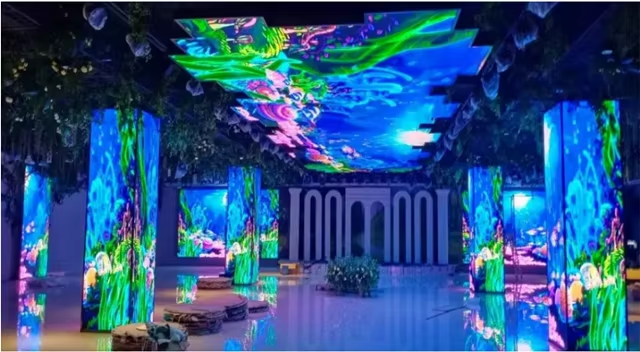
What are some common creative LED screens?
Introduction
First of all ,creative LED screens have revolutionized the way we perceive digital displays, offering innovative solutions that go beyond traditional flat panels. These screens come in various shapes, sizes, and functionalities, captivating audiences with their versatility and visual impact. Let’s explore five common types of creative LED screens and delve into their distinct features.
Characteristics:
The feature of creative LED screens is their ability to break away from traditional rectangular displays, offering dynamic and engaging visual experiences. They leverage advanced LED technology to deliver vibrant colors, high brightness, and seamless integration into diverse environments. These screens can be curved, transparent, flexible, interactive, or 3D, each with its unique set of features and applications.
Curved LED Screens:
Curved LED screens feature a concave or convex curvature, allowing for immersive viewing experiences and enhanced visual impact. They are usually used in panoramic environments, such as trade shows, exhibitions, and entertainment venues. Curved LED screens create a sense of depth and engagement, drawing viewers into the content.

Transparent LED Screens:
Transparent LED screens utilize transparent LED panels, enabling see-through displays that blend seamlessly with the surroundings. These screens are ideal for retail storefronts, museums, and architectural installations, where maintaining visibility and aesthetics is crucial. Transparent LED screens offer a unique way to showcase content while maintaining visibility and natural light transmission.

Flexible LED Screens:
Flexible LED screens feature bendable and foldable panels, allowing for creative installations on curved surfaces, pillars, or irregularly shaped structures. They are suitable for events, stage backdrops, and creative installations that demand unconventional display configurations. Flexible LED screens offer versatility and adaptability, enabling designers to explore new possibilities in visual storytelling.

Interactive LED Screens:
Interactive LED screens incorporate touch-sensitive technology, enabling users to interact with the display through gestures, touch, or motion. These screens are popular in interactive exhibits, retail environments, and educational settings, where audience engagement and participation are key. Interactive LED screens foster immersive experiences and enable dynamic content interaction, enhancing user involvement and retention.

3D LED Screens:
3D LED screens utilize advanced technology to create three-dimensional visual effects without the need for special glasses or equipment. These screens are used in entertainment venues, theme parks, and advertising campaigns to deliver immersive and captivating experiences. 3D LED screens provide depth and realism, allowing content to come to life and leaving a lasting impression on viewers.

Conclusion:
Creative LED screens offer a myriad of possibilities for captivating and immersive visual experiences across various industries and applications. From curved and transparent displays to flexible, interactive, and 3D screens, each type brings its unique charm and functionality to the forefront. By understanding the characteristics and applications of these creative LED screens, businesses and designers can leverage them to create memorable and impactful displays that engage audiences and elevate brand experiences.